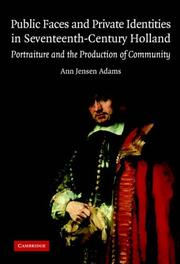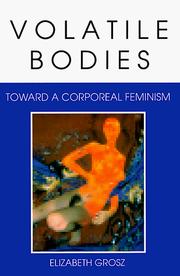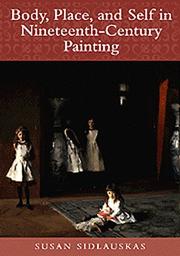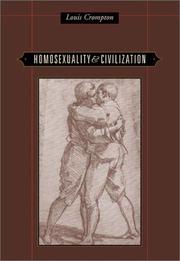| Listing 1 - 8 of 8 |
Sort by
|
Book
ISBN: 0691040613 Year: 1990 Publisher: Princeton University Press
Abstract | Keywords | Export | Availability | Bookmark
 Loading...
Loading...Choose an application
- Reference Manager
- EndNote
- RefWorks (Direct export to RefWorks)
portraits --- self-portraits --- Developmental psychology --- Rembrandt --- Identiteit (Psychologie) in de kunst --- Identity (Psychology) in art --- Identité (Psychologie) dans l'art --- Identity (Psychology) - Netherlands. --- Identity (Psychology) in art. --- Identity (Psychology) --- Paintings. --- Rembrandt Harmenszoon van Rijn, 1606-1669 - Self-portraits. --- Rembrandt Harmenszoon van Rijn --- Self-portraits --- Netherlands

ISBN: 9780521444552 0521444551 Year: 2009 Publisher: New York (N.Y.) : Cambridge university press,
Abstract | Keywords | Export | Availability | Bookmark
 Loading...
Loading...Choose an application
- Reference Manager
- EndNote
- RefWorks (Direct export to RefWorks)
Ann Jensen Adams examines four Dutch portrait genres of the 17th century in relation to inherited visual traditions, contemporary art theory, changing cultural beliefs about the body, about sight, and the image itself, as well as to current events.
Painting --- Noordelijke Nederlanden --- portraits --- social status --- anno 1600-1699 --- Netherlands --- Portrait painting, Dutch --- Identity (Psychology) in art. --- Art and society --- Art and society. --- Portrait painting, Dutch. --- History --- 1600-1699. --- Netherlands. --- Hollandse school
Book
ISBN: 9782356873927 2356873929 Year: 2015 Publisher: Bruxelles Ieper La Muette In Flanders Fields Museum
Abstract | Keywords | Export | Availability | Bookmark
 Loading...
Loading...Choose an application
- Reference Manager
- EndNote
- RefWorks (Direct export to RefWorks)
C3 --- beeldende kunst --- Wereldoorlog I --- islam --- christendom --- Kunst en cultuur --- Exhibitions --- conflict [general sense] --- Lahlou, Mehdi-Georges --- Identity (Psychology) in art --- Art, Moroccan --- Identité (Psychologie) dans l'art --- Art marocain --- Lahlou, Mehdi-Georges, --- Identité (Psychologie) dans l'art --- sculpting --- performance art --- multiculturalism --- installations [visual works] --- identity --- photography [process] --- video art --- gender issues --- Art --- Art, French --- Photography, Artistic --- Art français --- Photographie artistique --- Exhibitions. --- Expositions

ISBN: 0300075960 Year: 1998 Publisher: New Haven London Yale University Press
Abstract | Keywords | Export | Availability | Bookmark
 Loading...
Loading...Choose an application
- Reference Manager
- EndNote
- RefWorks (Direct export to RefWorks)
Art --- anno 1500-1599 --- self-portraits --- social status --- Iconography --- Italy --- Fontana, Lavinia --- Parmigianino --- Bandinelli, Baccio --- Anguissola, Sofonisba --- Raphael --- Alberti, Leon Battista --- Leoni, Leone --- Michelangelo --- Zuccaro, Federico --- Ghiberti, Lorenzo --- Bramante --- Lippi, Fra Filippo --- Filarete, Antonio di Pietro Averlino --- Mantegna, Andrea --- Titian --- Vasari, Giorgio --- Carracci, Annibale --- Leonardo da Vinci --- Cellini, Benvenuto --- Autoportraits italiens --- Identiteit (Psychologie) in de kunst --- Identity (Psychology) in art --- Identité (Psychologie) dans l'art --- Self-portraits [Italian ] --- Zelfportretten [Italiaanse ] --- 75.041.2 --- 7.034 <45> --- Portretschilderkunst --- Kunst van de renaissance; barok; rococo; koloniale stijl--Italië --- Artists --- Identity (Psychology) in art. --- Portraits, Renaissance --- Self-portraits, Italian. --- Social conditions. --- 7.034 <45> Kunst van de renaissance; barok; rococo; koloniale stijl--Italië --- 75.041.2 Portretschilderkunst --- Social conditions --- Self-portraits, Italian --- Italian self-portraits --- Renaissance portraits --- Persons --- Portraits [Renaissance ] --- Kunst --- maatschappelijke status --- zelfportretten --- Italië --- Buonarroti, Michelangelo --- Italiaanse school
Book
ISBN: 3897390299 Year: 1999 Publisher: Weimar V.D.G.
Abstract | Keywords | Export | Availability | Bookmark
 Loading...
Loading...Choose an application
- Reference Manager
- EndNote
- RefWorks (Direct export to RefWorks)
galerie van schoonheden --- historiated portraits --- Iconography --- Dyck, van, Anthony --- Kneller, Godfrey --- Reynolds, Sir Joshua --- Reynolds, Joshua --- Lely, Peter --- England --- Femmes dans l'art --- Identiteit (Psychologie) in de kunst --- Identity (Psychology) in art --- Identité (Psychologie) dans l'art --- Jeux de rôle dans l'art --- Role playing in art --- Rollenspel in de kunst --- Vrouwen in de kunst --- Women in art --- Portrait painting [English ] --- 17th century --- Themes, motives --- 18th century --- Women --- Portraits --- vrouwenportretten --- Engelse school

ISBN: 9780253208620 0253208629 9780253326867 0253326869 Year: 1994 Publisher: Bloomington: Indiana university press,
Abstract | Keywords | Export | Availability | Bookmark
 Loading...
Loading...Choose an application
- Reference Manager
- EndNote
- RefWorks (Direct export to RefWorks)
"The location of the author's investigations, the body itself rather than the sphere of subjective representations of self and of function in cultures, is wholly new.... I believe this work will be a landmark in future feminist thinking." "This is a text of rare erudition and intellectual force. It will not only introduce feminists to an enriching set of theoretical perspectives but sets a high critical standard for feminist dialogues on the status of the body." Volatile Bodies demonstrates that the sexually specific body is socially constructed: biology or nature is not opposed to or in conflict with culture. Human biology is inherently social and has no pure or natural "origin" outside of culture. Being the raw material of social and cultural organization, it is "incomplete" and thus subject to the endless rewriting and social inscription that constitute all sign systems. Examining the theories of Freud, Lacan, Merleau-Ponty, Foucault, Deleuze, Derrida, etc. on the subject of the body, Elizabeth Grosz concludes that the body they theorize is male. These thinkers are not providing an account of "human" corporeality but of male corporeality. Grosz then turns to corporeal experiences unique to women -- menstruation, pregnancy, childbirth, lactation, menopause. Her examination of female experience lays the groundwork for developing theories of sexed corporeality rather than merely rectifying flawed models of male theorists.
Feminist theory. --- Gender identity. --- Human body --- Social aspects. --- -Gender identity --- Feminist theory --- Gender identity --- 316.356.2 --- Sex identity (Gender identity) --- Sexual identity (Gender identity) --- Identity (Psychology) --- Sex (Psychology) --- Queer theory --- Feminism --- Feminist philosophy --- Feminist sociology --- Theory of feminism --- 316.356.2 Gezinssociologie --- Gezinssociologie --- Social aspects --- Philosophy --- Sociology of the family. Sociology of sexuality --- Body, Human --- Human body - Social aspects --- Gender dysphoria --- Body --- Psychoanalysis --- Psychology --- Sexuality --- Theory --- Biology --- Book

ISBN: 0521770246 9780521770248 Year: 2000 Publisher: Cambridge (UK) : Cambridge University Press,
Abstract | Keywords | Export | Availability | Bookmark
 Loading...
Loading...Choose an application
- Reference Manager
- EndNote
- RefWorks (Direct export to RefWorks)
"This book shows how and why the painted domestic interior, with figures positioned in provocative, and even disturbing, manners figured so prominently in contemporary visual culture. In these expressive images, the notion and limits of identity were debated rather than resolved. Body, Place, and Self in Nineteenth-Century Painting begins in the 1840s and examines the new ways of imagining and describing interior spaces. It ends in the years around World War I, when the devastations of the war left countless people with their private interiors either nakedly exposed or totally destroyed. Wide-ranging analyses of key individual works, including Edgar Degas's Interior, John Singer Sargent's Daughters of Edward Darley Boit, Edouard Vuillard's Mother and Sister of the Artist, and Walter Sickert's Ennui form the core of this study."--Jacket.
Painting --- Sargent, John Singer --- Sickert, Walter Richard --- Degas, Edgar --- Vuillard, Edouard --- anno 1900-1999 --- Espace (Art). --- Espace personnel. --- Huiselijkheid. --- Identity (Psychology) in art. --- Identité (Psychologie) dans l'art. --- Interieurs. --- Kunst. --- Körper --- Painting, Modern --- Peinture --- Personal space. --- Raumdarstellung. --- Schilderkunst. --- Space (Art). --- Themes, motives --- Themes, motives. --- Thèmes, motifs --- 1800-1899. --- Space (Art) --- menselijk lichaam. --- seksualiteit. --- psychologie. --- ruimte. --- interieurs. --- Degas, Edgar. --- Lecoq de Boisbaudran, Horace. --- Sargent, John Singer. --- Vuillard, Édouard. --- Sickert, Walter Richard. --- 19de eeuw.

ISBN: 0674030060 9780674030060 9780674011977 067401197X 067401197X 0674022335 9780674022331 Year: 2003 Publisher: Cambridge, Mass. : Belknap Press of Harvard University Press,
Abstract | Keywords | Export | Availability | Bookmark
 Loading...
Loading...Choose an application
- Reference Manager
- EndNote
- RefWorks (Direct export to RefWorks)
How have major civilizations of the last two millennia treated people who were attracted to their own sex? In a narrative tour de force, Louis Crompton chronicles the lives and achievements of homosexual men and women alongside a darker history of persecution, as he compares the Christian West with the cultures of ancient Greece and Rome, Arab Spain, imperial China, and pre-Meiji Japan. Ancient Greek culture celebrated same-sex love in history, literature, and art, making high claims for its moral influence. By contrast, Jewish religious leaders in the sixth century B.C.E. branded male homosexuality as a capital offense and, later, blamed it for the destruction of the biblical city of Sodom. When these two traditions collided in Christian Rome during the late empire, the tragic repercussions were felt throughout Europe and the New World. Louis Crompton traces Church-inspired mutilation, torture, and burning of “sodomites” in sixth-century Byzantium, medieval France, Renaissance Italy, and in Spain under the Inquisition. But Protestant authorities were equally committed to the execution of homosexuals in the Netherlands, Calvin’s Geneva, and Georgian England. The root cause was religious superstition, abetted by political ambition and sheer greed. Yet from this cauldron of fears and desires, homoerotic themes surfaced in the art of the Renaissance masters—Donatello, Leonardo, Michelangelo, Sodoma, Cellini, and Caravaggio—often intertwined with Christian motifs. Homosexuality also flourished in the court intrigues of Henry III of France, Queen Christina of Sweden, James I and William III of England, Queen Anne, and Frederick the Great. Anti-homosexual atrocities committed in the West contrast starkly with the more tolerant traditions of pre-modern China and Japan, as revealed in poetry, fiction, and art and in the lives of emperors, shoguns, Buddhist priests, scholars, and actors. In the samurai tradition of Japan, Crompton makes clear, the celebration of same-sex love rivaled that of ancient Greece. Sweeping in scope, elegantly crafted, and lavishly illustrated, Homosexuality and Civilization is a stunning exploration of a rich and terrible past.
Homosexuality --- Gender identity --- Homophobia --- Anti-gay bias --- Anti-GLBT bias --- Anti-homosexual bias --- Anti-LGBT bias --- Antigay bias --- Discrimination against gays --- Fear of gays --- Fear of homosexuality --- GLBT bias --- Homonegativity --- Homophobic attitudes --- Homoprejudice --- Lesbophobia --- LGBT bias --- Sexual orientation discrimination --- Discrimination --- Phobias --- Heterosexism --- Sex identity (Gender identity) --- Sexual identity (Gender identity) --- Identity (Psychology) --- Sex (Psychology) --- Queer theory --- History. --- History --- Homosexualité --- Identité sexuelle --- Homophobie --- Histoire --- Sociology of the family. Sociology of sexuality --- History of civilization --- Gender dysphoria
| Listing 1 - 8 of 8 |
Sort by
|

 Search
Search Feedback
Feedback About UniCat
About UniCat  Help
Help News
News